What Can I Do With a Chromebook Offline
Chrome Bone
The smart worker's guide to using a Chromebook offline
Chrome OS may be deject-centric at its core, but yous tin get enough accomplished offline on a Chromebook — if y'all set things upwardly thoughtfully in advance.
Stop me if you've heard this 1: A Chromebook is only a glorified browser in a box. Or this ane: Information technology's similar a "real" computer but without all the good stuff — and it's practically useless offline.
You see where we're going with this, right? Those are all wildly inaccurate myths that take plagued Chrome Os since its start. To be fair, some of them did have nuggets of reality back in the platform's earliest days, when it was yet a small-scale, beta-similar project within Google. Simply for years upon years now, Chromebooks accept been capable productivity tools that offer aplenty advantages over traditional desktop operating systems and work just likewise equally any other computers offline.
When it comes to offline effectiveness, the key — but like with a Windows or a Mac organization — is a healthy dose of planning and preparation. Some deject-centric services crave a touch of setup earlier they'll be functional offline, and some common piece of work tasks demand specific third-party software in place in lodge to be handled without an active internet connexion. None of that, even so, is difficult to do. And it's certainly not incommunicable.
If yous're using a Chromebook for work, think through the following 4 areas to make sure your computer is offline-set up and primed for productivity before the demand arises. Then, when your adjacent business organization flight takes off (hopefully shortly?), skip the barely usable airplane Wi-Fi and instead sit back, relax, and enjoy your Slack-interruption-free productivity session.
1. Make certain your Google apps are prepared for offline utilise
Google's core productivity apps are completely offline-capable — just in most cases, it'southward up to yous to take the initiative and gear up them up accordingly.
For Gmail:
- Open the Gmail website from your Chromebook, click the gear icon in the upper-right corner, and select "Encounter all settings" from the bill of fare that appears. Click "Offline" in the menu at the acme of the settings screen.
- Check the box adjacent to "Enable offline postal service."
- Make sure to carefully consider the remaining options on the page — how many days' worth of e-mail should be stored, whether attachments should be made available offline, and whether information should remain on your estimator even after you lot sign out (fine for a single-person computer) or should instead exist erased and resynced every fourth dimension yous sign out and back in (more advisable for a system that's shared by multiple people) — and choose the settings that make the nearly sense for your situation.
- Click the "Save Changes" push at the lesser of the screen, accept any confirmation prompts that popular upward, and and then await while Gmail reloads itself and downloads your data.
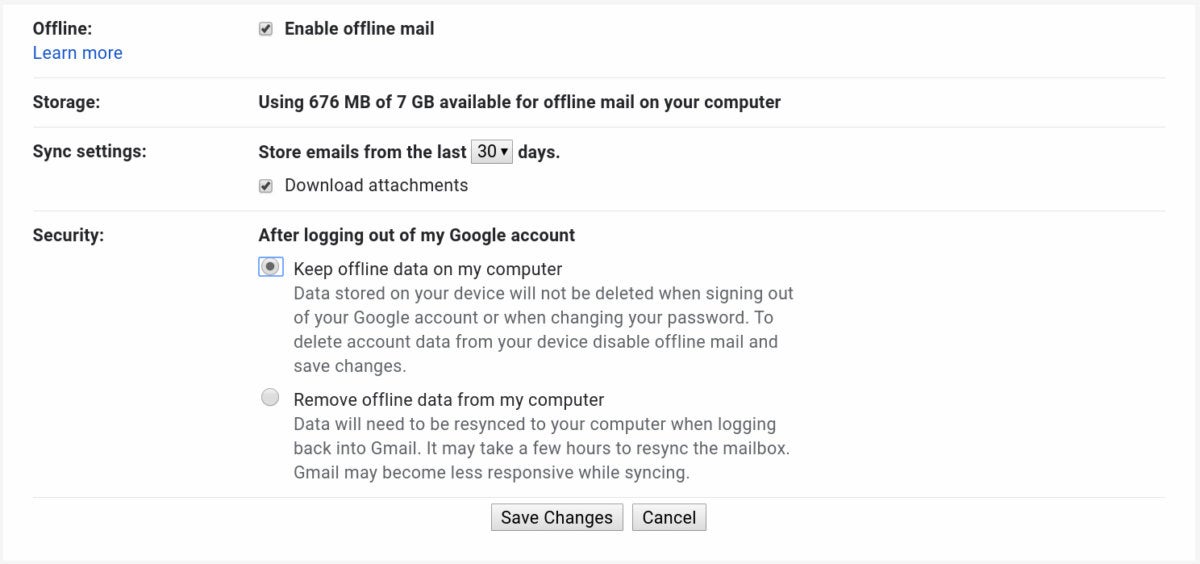 JR Raphael/IDG
JR Raphael/IDG Setting Gmail up for offline utilize takes all of 30 seconds to exercise. (Click any image in this story to enlarge it.)
At that place's just one more step, and it'south an of import one: Set up a bookmark in your browser for Gmail by pressing Ctrl-D — or, easier yet, create a shortcut for the site in your Chrome Bone shelf by clicking Chrome's three-dot menu icon while viewing Gmail, selecting "More tools," and then selecting "Create shortcut." Either fashion volition let you lot pull up the site and access your post when at that place isn't an active connectedness.
For Google Docs, Sheets, and Slides:
- Make sure y'all take the Google Docs Offline Chrome extension installed. (If yous see a blue box on its Chrome Web Store page that says "Remove from Chrome," you're practiced to go. If you see a box that says "Add to Chrome," you lot need to click that and follow the steps to complete the installation.)
- Get to the Google Drive website, click the gear icon in the upper-correct corner, and select "Settings" from the menu that appears.
- Look for the line labeled "Offline" in the settings box that pops up. If the box side by side to the phrase "Create, open, and edit your recent Google Docs, Sheets, and Slides files on this device while offline" isn't already checked, check it.
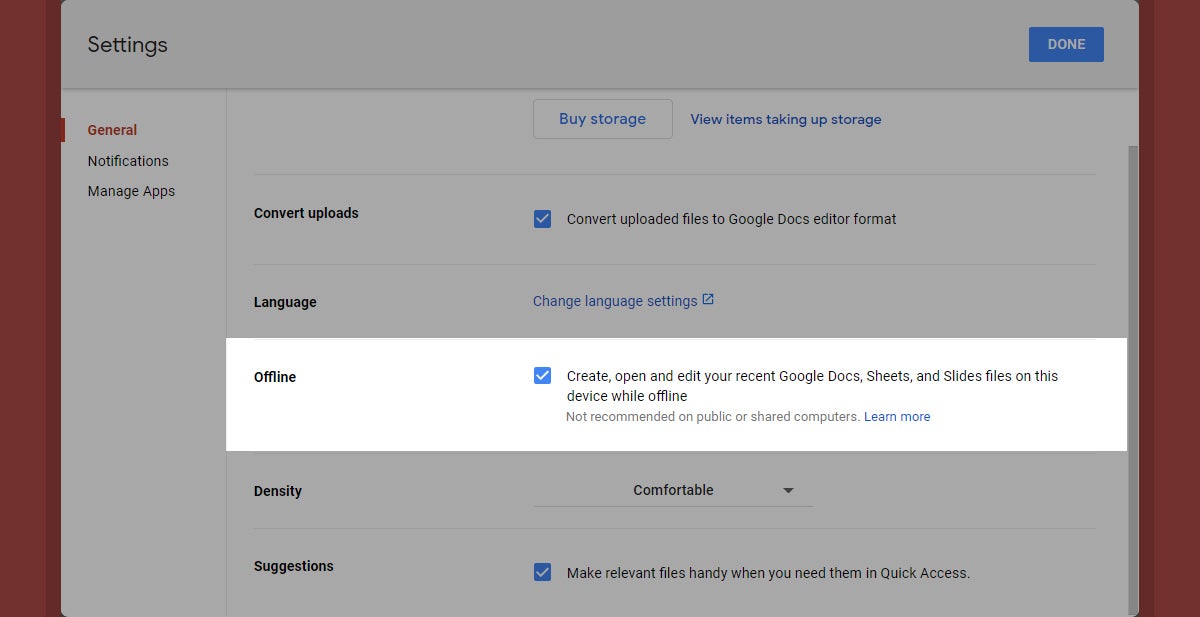 JR Raphael/IDG
JR Raphael/IDG One check of a box, and all your recent Docs, Sheets, and Slides files volition be available even without an net connection.
Just like with Gmail, you lot'll need to make certain you have a bookmark or shortcut created to pull upwards Drive when your Chromebook isn't continued. You'll also demand to double-check that the specific files you lot desire to piece of work with are prepare to be bachelor offline alee of time — as, rather annoyingly, Drive stores simply a vague drove of "recent files" by default, and yous don't want to assume that whatever yous need will be included.
Here'southward what to practice:
- Open up the Bulldoze website while y'all're online and find whatever Docs, Sheets, or Slides files you desire. (You tin also do this directly from the Docs, Sheets, or Slides websites, if you lot'd adopt.)
- Right-click on each file's title, then activate the toggle next to "Available offline," if it isn't already active.
- Repeat equally needed for whatever additional files.
For general Google-Drive-stored files:
That previous department addresses merely Docs, Sheets, and Slides files — not other types of files you lot've uploaded to Google Drive, such as images, PDFs, Nix archives, or MP3s. (It's a rather disruptive stardom to accept to brand, I realize, especially given how blurred the line is between Drive and the Docs-branded productivity apps. Hey, that's Google for ya.)
For any not-Docs, -Sheets, or -Slides files from your Drive storage that you need to be able to access offline:
- Open up the Files app on your Chromebook, then select "Google Drive" from the list of choices on the left.
- Find any file or folder y'all desire to make available offline, right-click it, and select "Bachelor offline" from the menu that appears — or simply click it and then actuate the "Available offline" toggle at the superlative of the Files window.
- If a file or folder is already available offline, you'll come across a checkmark next to its name.
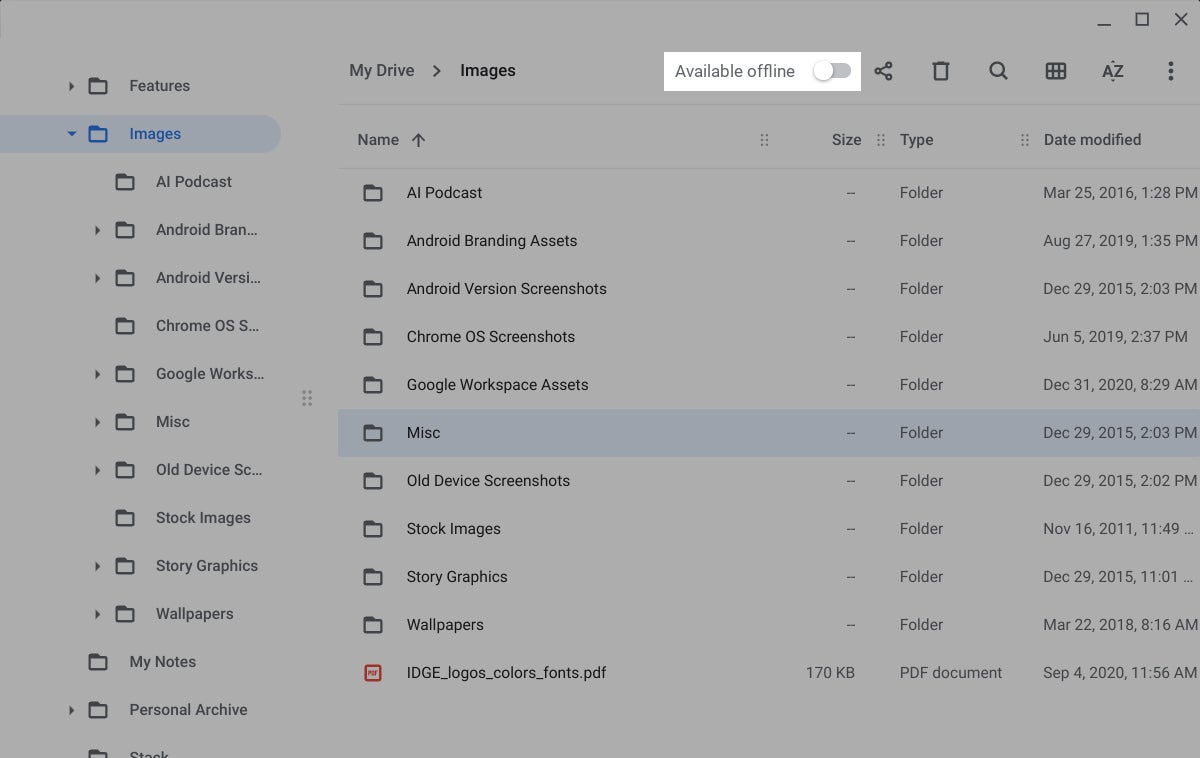 JR Raphael/IDG
JR Raphael/IDG The Chrome Os Files app holds the fundamental to making Drive files and folders accessible offline.
You lot'll and then exist able to admission those files from that same Files app anytime you lot're offline. And, of form, whatsoever files y'all've manually downloaded or copied to your Chromebook's local storage will already be available for offline use.
2. Figure out what other offline-gear up apps y'all have — and what you still need
Chrome OS comes with a handful of offline-ready basics, such as a calculator and a manifestly text editor. The aforementioned Files app is fully offline-friendly, also, and information technology includes a simple image viewer and editor forth with an sound player.
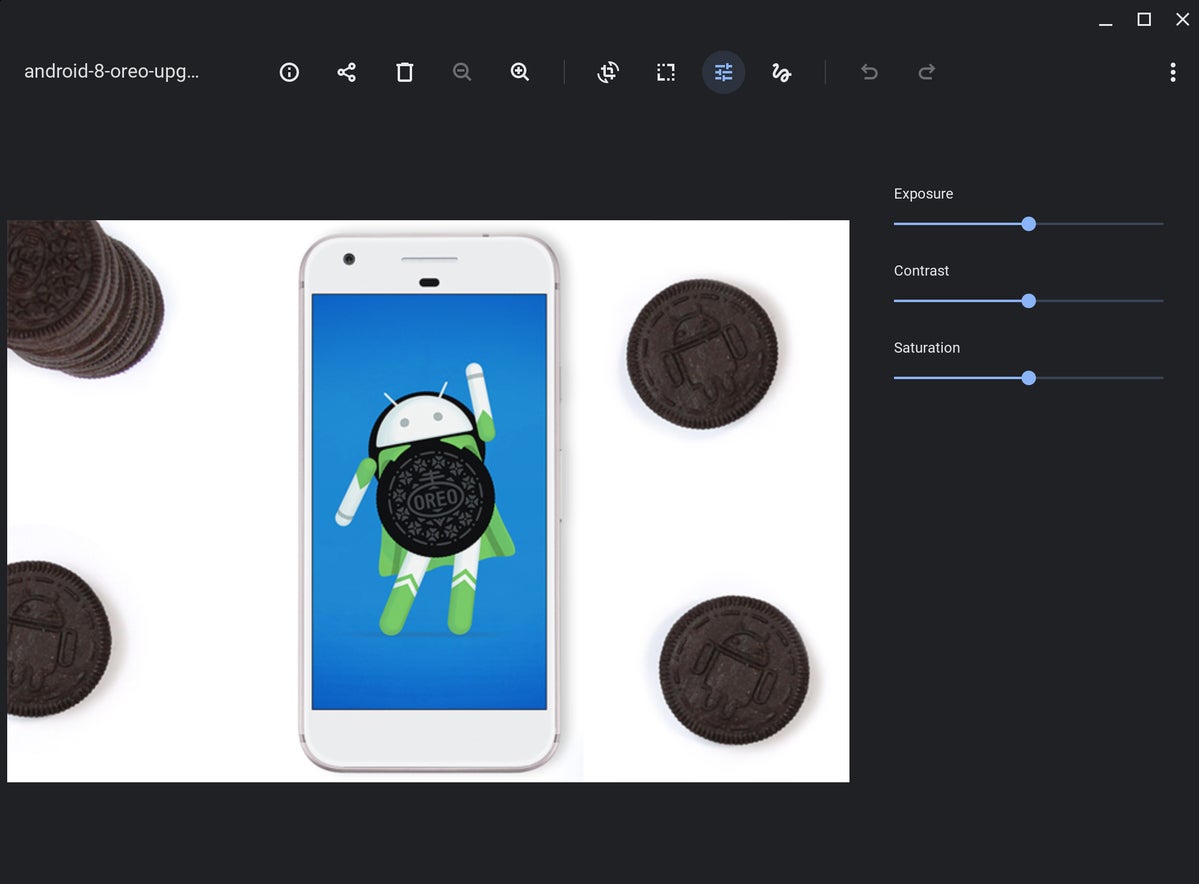 JR Raphael/IDG
JR Raphael/IDG Your Chromebook'due south Files app has its own built-in image editor.
Your Chromebook probably also came with Google Play Movies; that'll allow y'all to download movies and TV shows to continue yourself sane during a long flight (provided you're willing to pay to rent or buy the videos, of course).
Google's official Chrome Web Store has a broad variety of other offline-capable Chrome apps, only that native Chrome app form is set to be phased out and eliminated in June of 2022, so it's non the about advisable long-term option to get invested in at this betoken.
Luckily, though, you've got plenty of other possibilities to choose from.
3. Observe progressive web apps, Android apps, and Linux apps to fill up whatsoever remaining voids
Though it's nonetheless technically a cloud-centric platform, Chrome Os supports all sorts of apps these days — and odds are, you'll be able to find any y'all need among the software's more traditional-seeming app options.
The first category to consider is the progressive web app, which is a fancy way of saying an app that relies on the spider web and your browser to operate but looks and acts like a regular, standalone packaged program. When an app you need is available as a progressive web app, that's generally the fastest, simplest, and most effective form to apply.
The problem is that progressive web apps don't all work offline, and at this betoken, it's more often than not a game of trial and error to effigy out which ones do. Google had been working toward a requirement that'd force all progressive web apps to characteristic offline support in order to be compatible with Chrome, but that programme has been delayed indefinitely — so it's still annoyingly striking and miss as of now.
To come across if a service you employ has a progressive web app bachelor in the first place, become to the associated service's website in Chrome. Look toward the right cease of the address bar and see if you notice an icon that looks like a computer screen with a downwards-facing arrow on pinnacle of information technology. When you sign into the job management website Todoist, for example, you'll encounter that icon appear. And when you do, you tin can click it to install the site's progressive web app — after which signal information technology'll appear in your launcher and be almost indistinguishable from any other blazon of program.
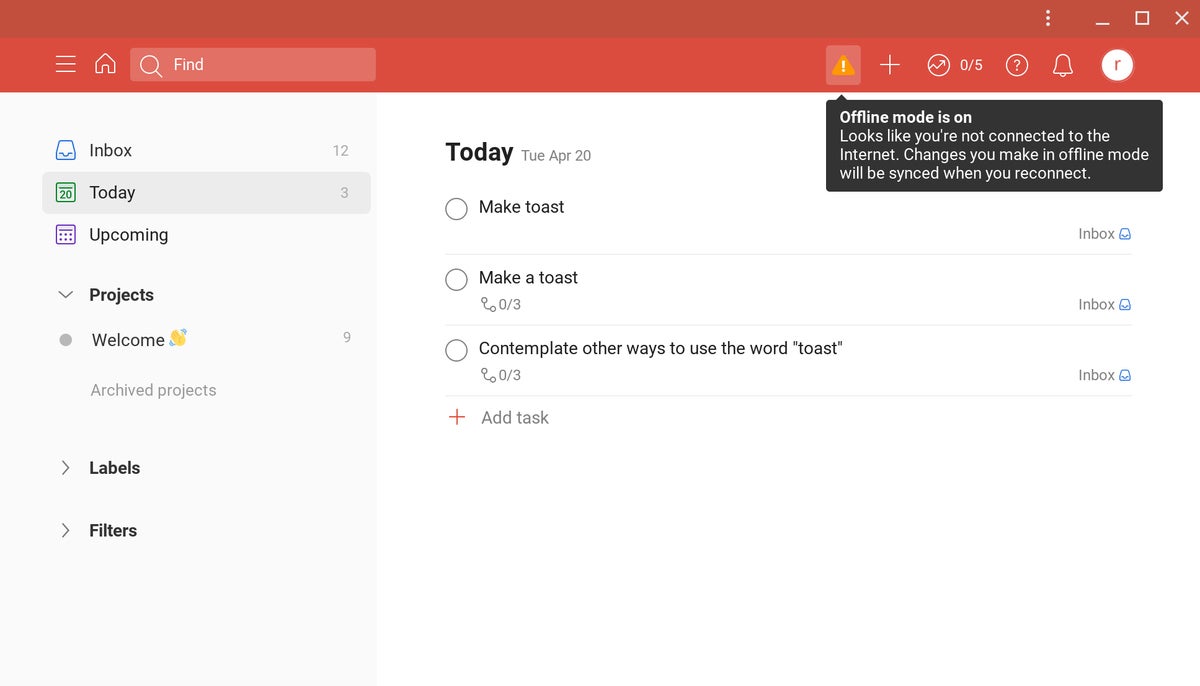 JR Raphael/IDG
JR Raphael/IDG Todoist offers an offline-capable progressive web app that works perfectly in the Chrome Os environment.
By embracing Android apps on your Chromebook, meanwhile, you lot can utilize both Google Go on and Google Agenda offline — something no other desktop platform supports. You can also stay connected to your data in services such as Evernote, OneNote, and Trello with or without an active internet connectedness, and with the correct subscriptions, you can fifty-fifty download videos from YouTube and Netflix for offline viewing (another perk that isn't possible on lots of regular laptops — hither's lookin' at y'all, MacBook!). Basically, if an app works offline on Android — which most do — information technology'll work offline on Chrome OS, too.
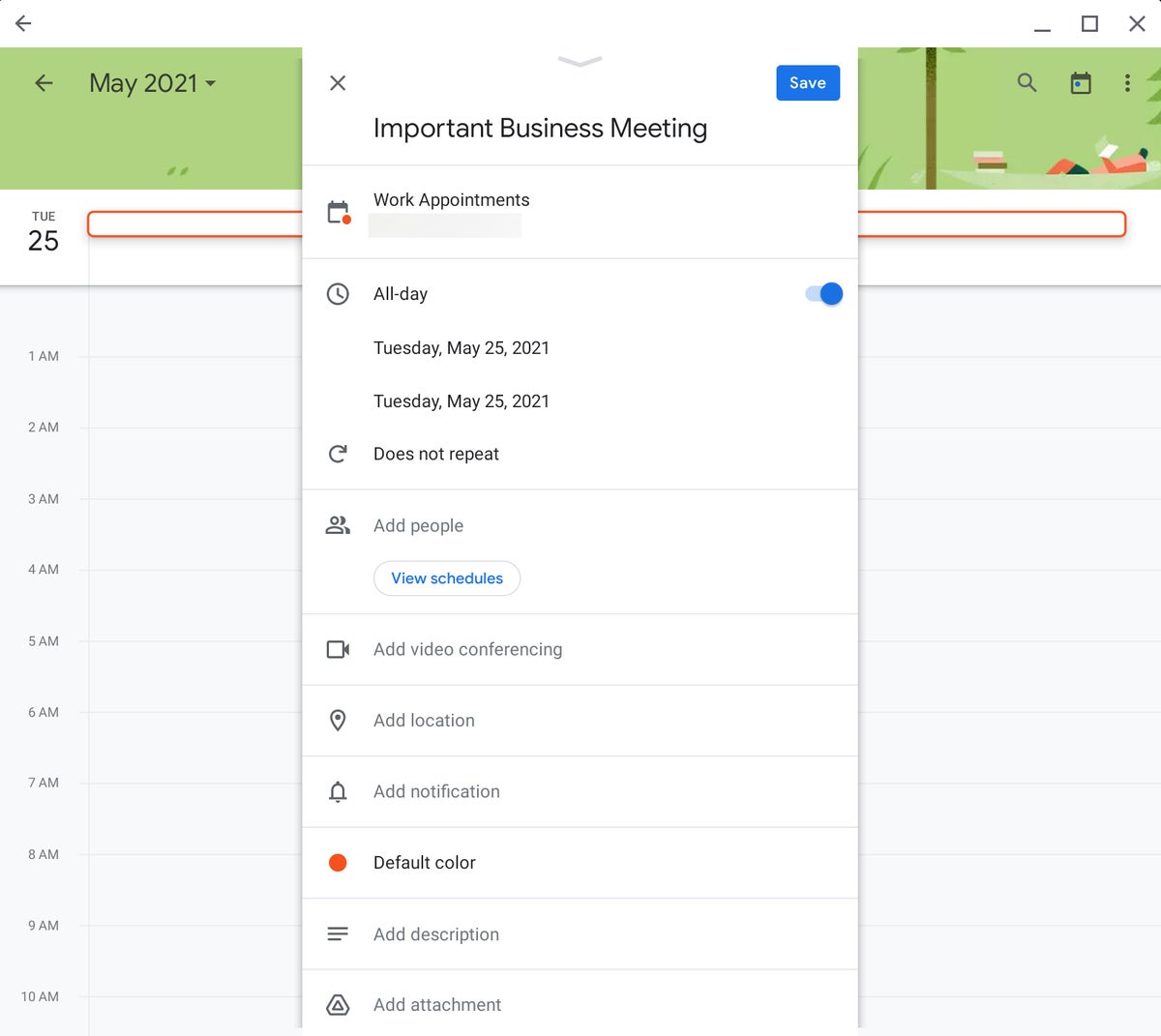 JR Raphael/IDG
JR Raphael/IDG With the Google Calendar Android app installed, your entire agenda is always at your fingertips — even when the net is not.
For even more than powerful possibilities, you might want to take the time to think about some Linux apps for your Chromebook — provided you take a recent enough system to handle such utilities. It's definitely power-user terrain, but information technology's not impossible to navigate. Click over to my step-by-step Linux-Chrome-OS guide to go started, and then check out my list of Chromebook Linux app recommendations for some standout ideas.
4. Requite yourself some offline-ready reading material
You lot may non be able to scan the web while you lot're offline, simply that doesn't hateful you lot can't catch upwardly on some worthwhile spider web-based reading.
The simplest mode to shop articles for offline use is to salve them straight in your browser: While viewing any website on your Chromebook, click the three-dot menu icon in Chrome'due south upper-correct corner, hover over "More tools," and and then select "Relieve page every bit." (Or hit Ctrl-S for an even faster way to become to the same place.) Striking Enter or click the Save push, and that'due south it: The entire folio you lot were viewing is now available for your offline reading pleasure.
When y'all're fix to notice the article, open Chrome's Downloads folio — either by looking for the "Downloads" option in the chief browser menu or by hit Ctrl-J while a browser tab is open — and then click on its championship in the listing that appears. The entire page will load as if you were looking at it live.
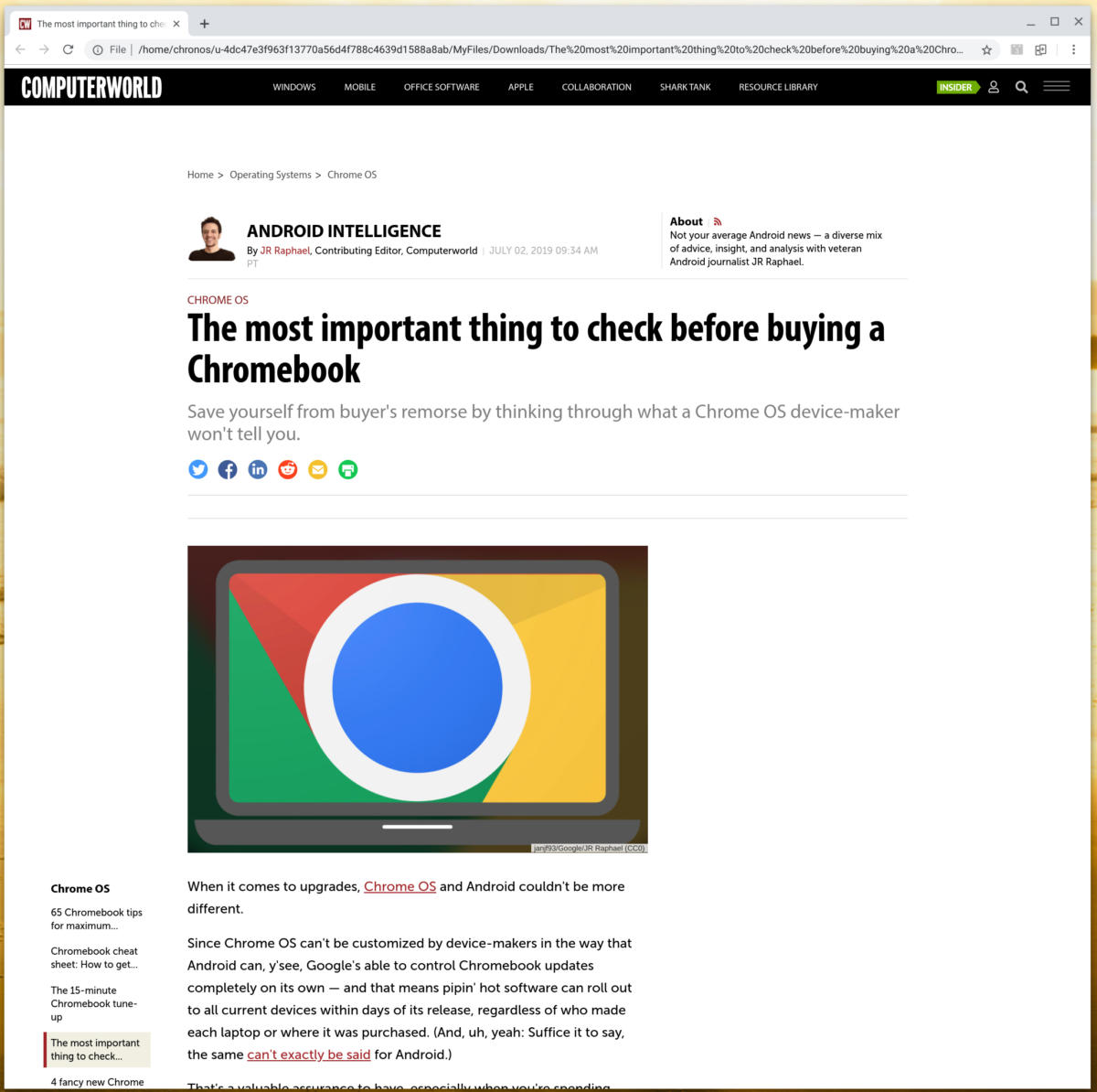 JR Raphael/IDG
JR Raphael/IDG An online article, offline — no complex hoop-jumping required.
If you'd rather have a more fully featured article-saving setup that works across multiple platforms, yous can utilise a service like Pocket, which offers an offline-friendly Android app — or my own personal pick for optimal commodity organization, Notion, which too has an Android app with some offline capabilities. Both services are free with optional premium upgrades that you probably won't need for basic link-storing purposes.
If books or magazines are what you're after, meanwhile, Amazon's Kindle Android app and Google's Play Books Android app both provide commendable reading experiences (more so than their web-based counterparts).
And with that, your Chromebook is officially ready for compromise-free offline productivity — and maybe even a lilliputian offline procrastination.
Don't worry: I won't tell.
This article was originally published in August 2022 and updated in June 2021.
Copyright © 2022 IDG Communications, Inc.
Source: https://www.computerworld.com/article/3410608/the-smart-workers-guide-to-using-a-chromebook-offline.html
0 Response to "What Can I Do With a Chromebook Offline"
Post a Comment